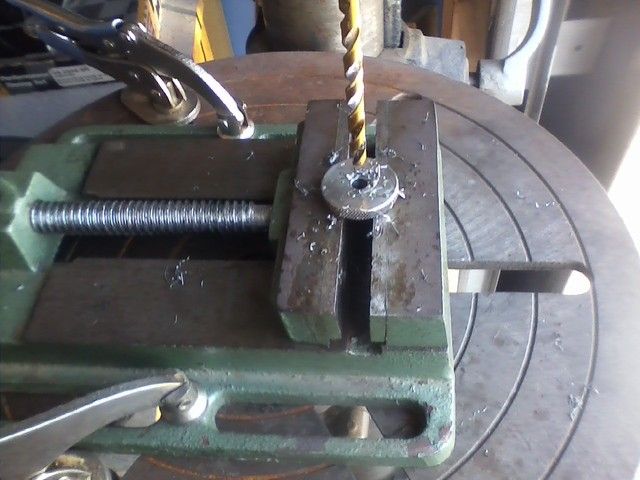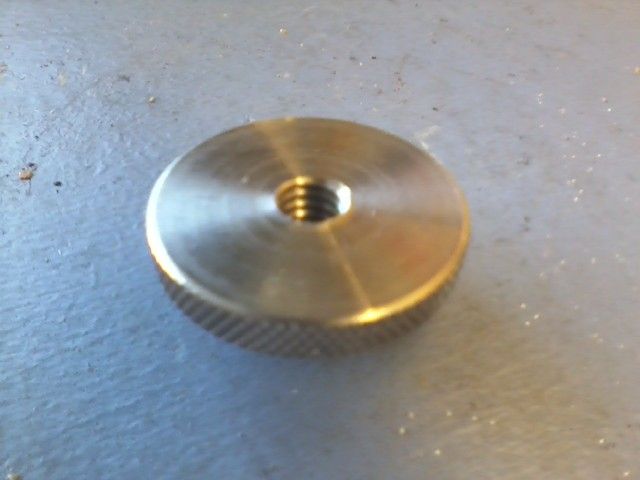mopowers
Well-Known Member
Which stainless steel is easier to drill and tap, 316 or 18-8?
Thanks!
Thanks!

Awesome. Thank you. I'm just opening the hole in a thumb nut and threading it for an air cleaner/carb stud. Similar to what's pictured:

I'm going to try this without breaking a tap, hopefully. Is hand tapping something like possible, or is it just a pipe dream? I've never worked with stainless before and the particular nut I need only comes in 18-8 and 316.
stainless steel is just any steel with nickel added.Nickel is not overly hard so it will be as hard as the parent steel.
1/4 turn clockwise followed by 1/2 turn back to clean your threads
If I can't find Tap Magic at any of the local hardware stores, if there a good substitute? I kinda want to get this done this weekend.
Oh yeah, thanks a lot for the advice guys. I appreciate it!
303 series Stainless is much more, drill, tap machine friendly than most other common series Stainless..........drilling 304, use a slower spindle speed than you might usually use, keep pressure on the bit, stainless will work harden, keep it cool, set up an air line to blow air on it . Use a GOOD drill bit and tap......better quality here makes a huge difference.
I work with Stainless all the time and I hate it.
Thanks treblig. Hopefully between the handful of hardware stores within a few miles of me, someone will carry Tap Magic. Up until now, I've always use WD40 or PB blaster. lol
303 series Stainless is much more, drill, tap machine friendly than most other common series Stainless..........drilling 304, use a slower spindle speed than you might usually use, keep pressure on the bit, stainless will work harden, keep it cool, set up an air line to blow air on it . Use a GOOD drill bit and tap......better quality here makes a huge difference.
I work with Stainless all the time and I hate it.
How would you compare the machining properties of 18-8 and 316? Those two are my choices.
Well, It turns out the Grainger near my house sells Tap Magic cutting oil. I'm going to pick some up today after work.
I've got a couple 1/4-20 taps. I'm not quite sure if they're HSS, but they're older American made taps. I'll look at them closer and see if they say HSS. Is there another way to find out?
stainless steel is just any steel with nickel added.Nickel is not overly hard so it will be as hard as the parent steel.
1/4 turn clockwise followed by 1/2 turn back to clean your threads
The biggest thing about stainless is, when is starts getting hot, it becomes work hardened, making it more difficult to machine.


Got it done guys. Thanks for the pointers. It actually wasn't as bad as I thought. No broken taps or drill bits, so I'm a happy dude.


Well that came out very nice. If I had known you had a drill press a would have told you to drill the hole then put a chamfer on top edge of the hole with a larger drill bit to give the tap a easy way to start the first thread. Then before you move anything you stick a pointed 1/4" rod in the chuck and (using hand pressure) you can use the point on the rod to insert in the backside of the tap. Just about every tap I've seen has a counter sink on the back end so you can support the tail end of the tap as you start the first thread. By pressing down on the drill press handle as you turn the tap you'll ALWAYS get a straight start on the hole. When you "back the tap up" you relieve the pressure so it can come up out of the hole. After you break the binding you apply hand pressure again and keep tapping until you finish the thread.
Good Job!! Sometimes it's EASY and sometimes it's a BEAR, it depends what alloy of stainless you're tapping. It also depends on well prepared you are when you start!! You were prepared!!
treblig
